With the right approach, you can sustain a year-round blanket of uncultivated beauties in your own backyard.
As we settle into the first white-hot days of summer, the last stalks of this year’s memorable wildflower show are finally disappearing beneath whirling blades. It’s been a storybook spring, with roadsides and landscapes blanketed in color thanks to spring rain. But the last showers have moved on and the mowers have moved in.
Although annual wildflowers only last a single season, you don’t have to settle for mowed grass and irrigation bills for the rest of summer. With the right approach and palette of tough plants, you can sustain a year-round blanket of wildflowers in your own garden by learning this perennial lesson of Texas landscaping: Native colors don’t run!
Remember, even in the full scorch of summer, many native perennials will erupt in springlike flushes of reblooms with just a touch of rain. This is true even in the worst drought. While no amount of supplemental water seems to be enough to satisfy turf grass, the slightest shower can elicit an immediate response from our native plants.
That’s because they’ve evolved to live in Texas extremes of scorching drought and occasional bursts of rain. As you’ve seen in any nature documentary, when the opportunities to complete a life cycle arrive infrequently, Texas native plants are poised to quickly make the most of them.
WHAT IS A PERENNIAL? Perennials plants that live longer than two years, distinguished from annuals (1 year) and biennials (2 years.)
Perennials develop overwintering root structures that enable them to return in spring even if they freeze back to the ground in winter. Shrubs and trees are perennial, as are many flowering non-woody plants.
A classic example is cenizo Texas sage. It’s a nearly evergreen silverleaf shrub popular in both home and commercial landscaping, but since it grows wild throughout southwest Texas, it’s not fazed by anything our harsh weather can throw out. In a typical summer it waits unblinking through the harshest summer temperatures and the near-absence of any kind of moisture — only to burst into feverish blooms when thunderstorms arrive, coloring roadsides all the way across the South Texas Plains. That’s why it’s commonly called the “barometer bush.”
Interestingly, though it responds well to rain cenizo is considered merely tolerant of automatic irrigation (quite a statement considering how often it’s used in irrigated landscaping). Too much water can cause cotton root rot on cenizo and many native plants. But interestingly, all that extra water isn’t always enough to make it bloom. It’s those sudden thunderstorms that really wake it up.
Many native plants are similar in their approach to water. They’re loaded with water-saving devices like fuzzy leaves, tiny hairs and leaf shapes, sizes and textures that minimize water loss — all of which means they don’t need irrigation to thrive.
With native plants, you can forgo the cost and constant worry of irrigation and dying non-native plants. Garden like a true Texan and save water and time for tubing on the Guadalupe! In the words of Dolly Parton, “When a flower grows wild, it can always survive.”
While there are endless possibilities of native plants, below are a few stalwarts that’ll color your landscape like a spring day even in summer, and with a big payoff whenever rainfall appears.
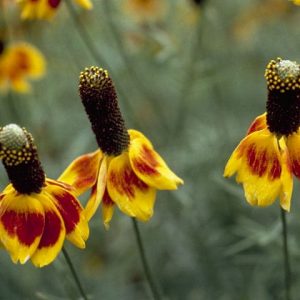 Prairie coneflower – Unlike many annual wildflowers, prairie coneflower is actually a perennial plant meaning it returns year after year from the roots, though it can be shorter-lived in a garden setting. The “Mexican hats” are distinctive and provide instant native Texas cred to any summer landscape. Prairie coneflower – Unlike many annual wildflowers, prairie coneflower is actually a perennial plant meaning it returns year after year from the roots, though it can be shorter-lived in a garden setting. The “Mexican hats” are distinctive and provide instant native Texas cred to any summer landscape. |
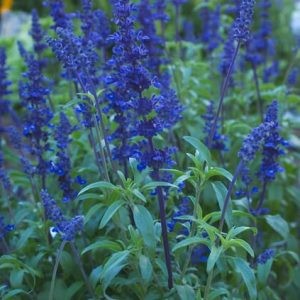 Mealy cup sage – This was a spectacular spring for Salvia farinacea and its many cultivars. A bluish-purple salvia with showy wands of flowers, it evokes the look of spring wildflowers, coming and going until November. Like Zexmenia, it’s low-growing and non-fussy (in fact these two make a great color pair.) Mealy cup sage – This was a spectacular spring for Salvia farinacea and its many cultivars. A bluish-purple salvia with showy wands of flowers, it evokes the look of spring wildflowers, coming and going until November. Like Zexmenia, it’s low-growing and non-fussy (in fact these two make a great color pair.) |
A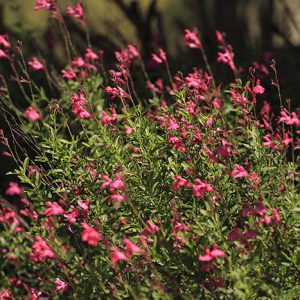 utumn sage – The (misnamed) autumn sage actually blooms from spring until frost — and even heavier after any rain. It’s so widely used in landscaping and there are so many varieties, that it can be easy to overlook — except in summer when it’s a workhorse in the water-saver garden. utumn sage – The (misnamed) autumn sage actually blooms from spring until frost — and even heavier after any rain. It’s so widely used in landscaping and there are so many varieties, that it can be easy to overlook — except in summer when it’s a workhorse in the water-saver garden. |
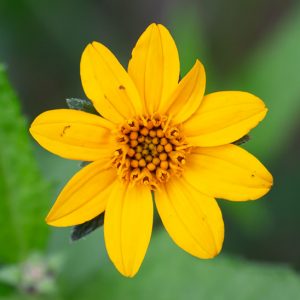 Zexmenia – Also known as Texas creeping oxeye, this widely available but underused native plant resembles daisies, with cheerful blooms on a low-growing mass. It’s a plant that specifically promotes water conservation since too much water makes it leggy! Since it’s a confusing genus and there are some invasive lookalikes, it is best purchased from native plant vendors. Look for the scientific names Wedelia texana or Wedelia acapulcensis var. hispida on the tag. Zexmenia – Also known as Texas creeping oxeye, this widely available but underused native plant resembles daisies, with cheerful blooms on a low-growing mass. It’s a plant that specifically promotes water conservation since too much water makes it leggy! Since it’s a confusing genus and there are some invasive lookalikes, it is best purchased from native plant vendors. Look for the scientific names Wedelia texana or Wedelia acapulcensis var. hispida on the tag. |
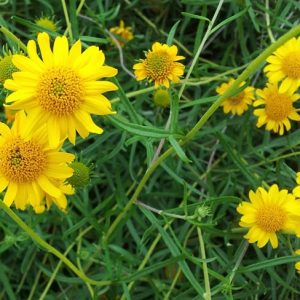 Goldeneye – Evoking the fields of gold that cover Southwest Texas ranches in summer and autumn, skeletonleaf goldeneye is increasingly popular as a landscape specimen around town, in part because it survives so well putting up with heat, cold and landscapers. Since it stays evergreen in winter, it tends to persist with a sprinkling of non-fussy daisy flowers in warm weather and after rains. (Plateau goldeneye is a close relative that blooms even in shade.) Goldeneye – Evoking the fields of gold that cover Southwest Texas ranches in summer and autumn, skeletonleaf goldeneye is increasingly popular as a landscape specimen around town, in part because it survives so well putting up with heat, cold and landscapers. Since it stays evergreen in winter, it tends to persist with a sprinkling of non-fussy daisy flowers in warm weather and after rains. (Plateau goldeneye is a close relative that blooms even in shade.) |
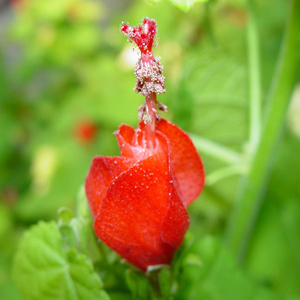 Turk’s cap – The “lazy hibiscus” — its hibiscus flowers stay curled up in a jaunty whirl — is easy to grow in the shade of existing trees. Turk’s cap grows up into a small shrub and in the glow of a summer evening its flowers resemble candles. |
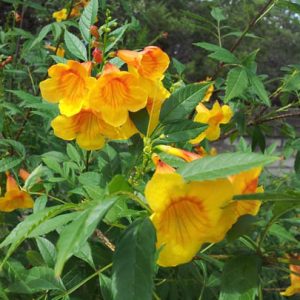 Esperanza – For masses of summer color, you can’t be disappointed with esperanza or yellow bells. It’s a plant well acquainted with heat, drought and hurricanes, with a native range everywhere from Arizona to Texas, Mexico and the Caribbean. There are many cultivars to choose from, and Texas plants have thinner leaves. It freezes back to the ground every winter. Esperanza – For masses of summer color, you can’t be disappointed with esperanza or yellow bells. It’s a plant well acquainted with heat, drought and hurricanes, with a native range everywhere from Arizona to Texas, Mexico and the Caribbean. There are many cultivars to choose from, and Texas plants have thinner leaves. It freezes back to the ground every winter. |


